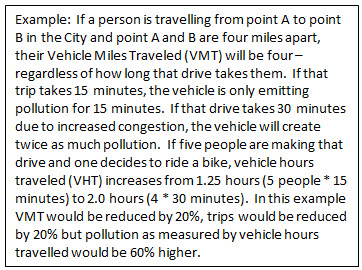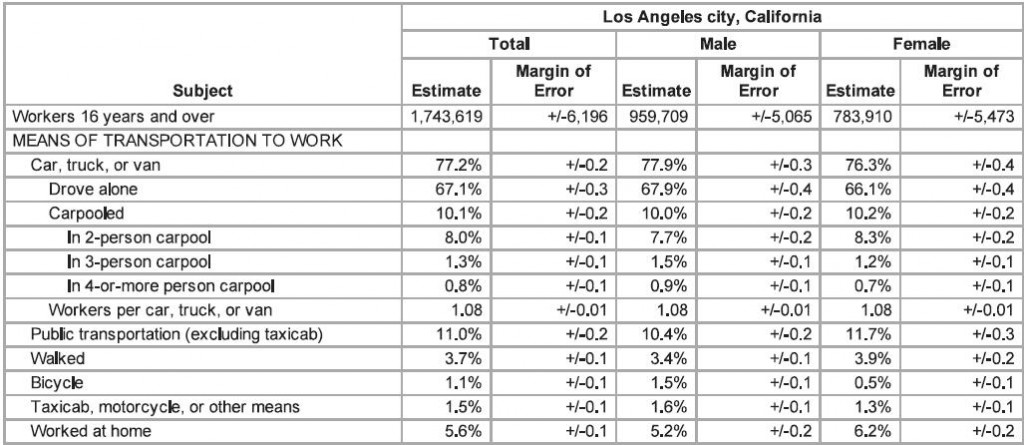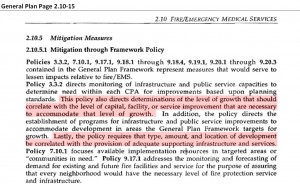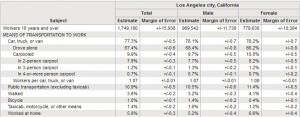First off, FTC supports increasing mobility for Los Angeles. We support encouraging alternatives to motor vehicles. We support improved air quality. Why then not support MP2035? It is because MP2035 is not a mobility plan – it is a plan designed to create immobility while enabling increased development and density.
MP2035 exposes itself as a false “mobility” plan from the start. It states point blank that reducing traffic congestion is not its goal. For the vast, vast, vast majority of us in this City, being stuck in traffic is the precise opposite of mobility. And that is what this plan promises to do – stick us in more traffic.
In fact, this so-called mobility plan states (and in fact relies on the fact) that it will increase traffic congestion by, among other things, removing traffic lanes used by cars for buses and bikes. Far from trying to reduce traffic congestion, the (mostly unstated) theory is that if traffic congestion becomes SO unbearable (even more than it already is) it will magically force people to take other forms of transit – whether they currently exist or not, are convenient or not or are economical or not.
Removing traffic lanes for the overwhelming bulk of traffic (see US Census chart at the bottom) decreases the capacity of the street. This not only creates longer commutes, but also forces drivers to seek alternative routes which, according to MP2035, will be right through residential neighborhoods.
The LA Times quotes a Senior City Planner as presenting this bit of twisted logic: “Slower moving traffic does not necessarily lead to congestion. Those two are separate. Slower traffic can actually in some ways accommodate more cars moving through an area.”
That’s the kind of logic that tells you the best way to save a drop of water is to approve huge development projects that consume tens of millions of gallons of water, or that the best way to put out a fire is to douse it with gasoline.
People need look no further than this quote from the LA Times: “The City’s Environmental Impact Report concluded that the plan’s projects, if completed by 2035, would result in “unavoidable significant adverse impacts,” including additional noise, cut-through traffic and diminished access for emergency vehicles. The report also found that there would be a considerable increase in the percentage of major streets that are highly congested during evening rush hour.”
This is not Fix The City’s opinion or analysis. This is the City’s analysis. Strange: None of those speaking in support of MP2035 highlighted this conclusion, though one council member dismissed any negative conclusions as “worst-case scenarios needed to avoid legal challenges.” Given that the council must base their decision on substantial evidence presented in the MP2035 study, such unsubstantiated conclusions may be hard to defend.
Perhaps most troubling is the last “unavoidable significant adverse impacts“ mentioned above: That increasing traffic congestion on major streets not only slows regular traffic down, but it slows down emergency response vehicles. Again, this too is admitted by the MP2035 plan.
In 2012, Fix The City’s data analysis exposed (first through KNBC and then extensively in the LA Times) that LAFD response times were falling short – way short, of the City’s stated metric of arrival within 5 minutes after dispatch, 90% of the time. At that time councilmembers were outraged. They promised immediate action to improve this most basic service: Ensuring the safety of the City’s residents.
According to the LA Times, then-Council member Dennis Zine said “he would not have voted for the cuts [to the fire department] if he knew the department was getting to emergencies in less than five minutes only 64% of the time, a figure lower than the 90% goal set by the National Fire Protection Assn.” No such out for current councilmembers who voted yes on MP2035.
Since that time, response times have gotten worse and worse with the 5 minute/90% metric falling to under 60% for the City overall. This last year the City Council congratulated itself for “addressing the problem” by including hiring in the current budget for the first time in years.
Unfortunately, not only is the approved hiring not even sufficient to replace firefighters lost to attrition, it does nothing to replace firefighters lost in previous years or to increase the number of firefighters needed to deal with increased population and density – and now decreased mobility for first responders.
Instead of doing what it takes to improve response times, the Council has approved a plan that admits it will harm response times. To Fix The City, this is simply unacceptable. Even more unacceptable is that certain council members hailed the plan as improving safety when the text of the plan and the plan’s analysis yields the opposite conclusion.
Even more callous is the public description of MP2035 as being one that increases public safety when the City’s own admissions show the reverse. Yes, theoretically 1% of the people may be safer, but 100% of us will experience even more dangerously poor response times. (This is in no way meant to diminish the members of the LAFD who are truly amazing at what they do despite being given insufficient resources)
Below the surface, it is the hidden agenda of the MP2035 plan that links traffic congestion, emergency response times and consumption of other key resources such as water: The drive for increased density – even though the City cannot handle its current density.
Far more than being a mobility plan, MP2035 is actually a development-enablement plan which will have a dramatic effect on increased density in the City with all of its impacts.
How? To combat troublesome neighborhoods from raising concerns about local impacts and the livability of their neighborhoods, the State legislature passed several laws granting expedited review or exemption from certain review for projects near transit (oddly just like the transit proposed by MP2035).
Chief among these is SB743 which states “This bill would provide that aesthetic and parking impacts of a residential, mixed-use residential, or employment center project, as defined, on an infill site, as defined, within a transit priority area, as defined, shall not be considered significant impacts on the environment.” Tell that to the people that live in that environment. AB744 provides for density bonuses within 1/2 mile of a major transit stop (which is pretty much everywhere once MP2035 is implemented).
MP2035 studied none of this growth-inducing impact, nor did it study the increased funding for “transit-oriented development” that may result from non-City sources.
What should further frustrate this City’s residents is that far from being a representative democracy in which our council members are allowed to represent their area’s interests, this City is increasingly run by a very few people who were not elected by those their decisions impact.
The recent Council vote on MP2035 had Council Members Koretz and Cedillo asking for modifications of the plan in their areas. In theory, those council members were elected by their constituents to represent them and their interests. It is expected that council members will have the ability to impact policy in their own districts.
Councilman Cedillo said it best when he said “I have to be a representative for the entirety of my district, not simply 1%.” (He was referring to the fact that bike lanes would remove 50% of capacity for 85% of commuters while bike riders represent only 1% of trips.)
Instead, other council members ignored their colleagues. Oddly, the elected class then wonders why voting in this City has declined to such low levels. Why take the time to vote for council members if they can’t impact policy in their own districts?
We also wonder if the Council truly understands that AB2245 exempts the City/LADOT from having to conduct ANY further study for bike lane restriping once MP2035 is installed. AB2245 “exempts from CEQA the restriping of streets and highways for bicycle lanes in an urbanized area that is consistent with a prepared bicycle transportation plan.” No doubt there will be battles over what “restriping” is as the City attempts to shoehorn MP2035 projects into AB2245.
There is another troubling and misleading conclusion presented by the City: That MP2035 will reduce pollution. It is well established in the literature, and in common sense, that increasing congestion and therefore the time vehicles are operating leads to increasing air pollution.
So how do MP2035’s supporters attempt to circumvent this simple logic? They attempt to use a metric called “Vehicle Miles Travelled(VMT)” instead of the current “Level Of Service(LOS)” or more logical “Vehicle Hours Traveled(VHT).”
Given that motor vehicles of all types represent the bulk of trips in the City, there truly is no other conclusion other than one that states the obvious: Increased congestion for motor vehicles will worsen air quality.
The basic focus of “LOS” is to determine local impacts on intersections near a development project based on how free-flowing traffic is through that intersection. LOS A means no traffic/free flow, LOS F means traffic jams/no mobility.
A huge project that creates 10,000 new trips per day would clearly impact local traffic in the area around the project. It was getting harder and harder to justify building new mega-projects in areas with LOS F gridlocked traffic. This analysis has annoyed pro-density forces as it had the nasty side effect of showing huge impacts on residents, businesses and neighborhoods near the project. This made for bad politics.
So, what is the solution for pesky analyses that show negative local impacts? You simply need to pull back a bit and look at the larger(and unprovable) picture until you are so far away that local neighborhood impacts can no longer be seen.

A plan such as MP2035 that will have major negative local impacts would merely try to do some fancy footwork to claim that because of unmeasurable efficiencies, overall regional VMT will be reduced. What goes unstated is that this approach, even if valid and provable, has at its heart ignoring impacts on local neighborhoods in favor of some theoretical larger regional improvement.
Forget that local traffic will be even more soul-crushing than it is now. Forget that local first responders won’t be able to get to neighborhoods fast enough. Forget that local air quality will be negatively impacted. Forget that parking and traffic lanes will be removed causing harm to local businesses. For voters, the most troubling is that some councilmembers have accepted this approach: Region/politics first, neighborhoods last.
One of the most frustrating parts of the MP2035 plan is that it is wholly inconsistent with itself and with other City policies, plans and laws. Among these are the General Plan, Community Plans and several up and coming plans.
Nothing highlights the hypocrisy better than simultaneous support for MP2035 which admits it will increase congestion (which it counts on to discourage car use) and support for the “Westside Mobility Plan” which labels congestion as the enemy and seeks its reduction.
Three days before the council approved MP2035, it approved a motion to extend the $200,000+ contract for the Westside Mobility Plan. Yes, the City is spending money in one place to solve the problems it is spending other money to create. Our tax dollars at work.
One interesting admission was made by the City through its planning department and through the council: That it is no longer possible to improve traffic congestion by widening lanes or using other measures. This will come as a huge surprise to developers that have produced environmental impact reports which come to the opposite conclusion. Ironically, these same environmental impact reports that say it IS possible to reduce congestion by making physical changes are universally given a stamp of approval by the City including the Council. Those studies and their traffic conclusions may now no longer be supportable.
Fix The City supports improving public safety and improving the quality of life. There is no more basic responsibility a City has than to the life, liberty and pursuit of happiness of its residents. Fix The City strongly believes that a plan that harms first responders’ ability to get to those who need help threatens the lives of the residents of the City. We believe that being caught in ever-increasing traffic jams caused by over-development and now decreased road capacity keeps us prisoners in our cars and keeps us away from our families. Not only does this impact our quality of life and our pursuit of happiness, but it makes pursuing happiness take far longer and far less happy.
Fix The City will be pursuing a legal challenge to the MP2035 on multiple grounds towards the goal of having an honest and productive policy which improves the quality of life for all of the City’s residents in all of the City’s neighborhoods.
2013 ACS Transportation Survey






